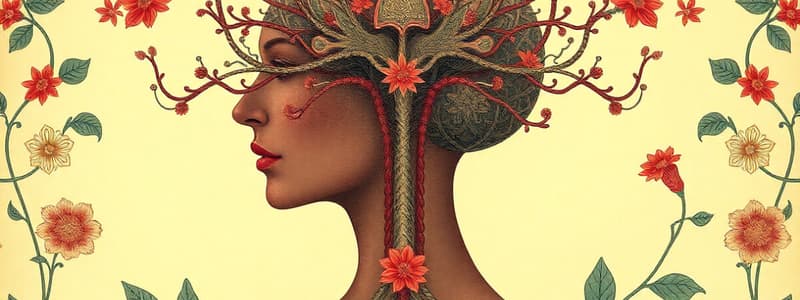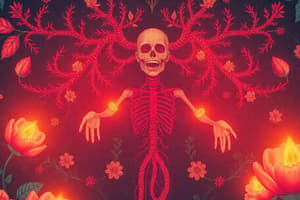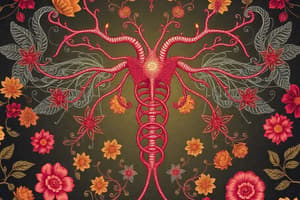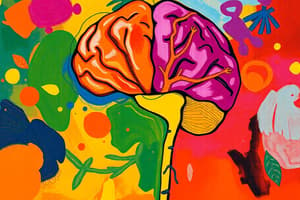Podcast
Questions and Answers
What is the function of thyroxine?
What is the function of thyroxine?
- Stimulates release of calcium from bones
- Lowers blood sugar
- Converts glycogen to glucose
- Increases metabolic rate of most body cells (correct)
Which hormone promotes the reabsorption of water in the kidneys and sweat glands?
Which hormone promotes the reabsorption of water in the kidneys and sweat glands?
- Melatonin
- Growth hormone
- Anti-diuretic hormone (ADH) (correct)
- Thyroxine
Which part of the nervous system is responsible for the 'fight or flight' response?
Which part of the nervous system is responsible for the 'fight or flight' response?
- Parasympathetic Nervous System
- Autonomic Nervous System
- Somatic Nervous System
- Sympathetic Nervous System (correct)
What is the function of insulin?
What is the function of insulin?
Which organ produces estrogen and progesterone?
Which organ produces estrogen and progesterone?
What is the main function of testosterone?
What is the main function of testosterone?
Which hormone is released by the adrenal glands in response to stimulation by Adrenocorticotropic Hormone?
Which hormone is released by the adrenal glands in response to stimulation by Adrenocorticotropic Hormone?
Which hormone is responsible for stimulating milk production?
Which hormone is responsible for stimulating milk production?
Which of the following is NOT a part of the Central Nervous System (CNS)?
Which of the following is NOT a part of the Central Nervous System (CNS)?
What is the primary function of progesterone?
What is the primary function of progesterone?
What is the primary function of Thyroxine?
What is the primary function of Thyroxine?
What is the role of the meningeal layers?
What is the role of the meningeal layers?
Which of the following is NOT a function of the placenta?
Which of the following is NOT a function of the placenta?
Which of the following is responsible for voluntary movement and sensory processing?
Which of the following is responsible for voluntary movement and sensory processing?
Which of the following hormones is NOT released by the anterior pituitary gland?
Which of the following hormones is NOT released by the anterior pituitary gland?
What is the location of the pancreas?
What is the location of the pancreas?
What is the name of the three-pound organ that controls all functions of the body?
What is the name of the three-pound organ that controls all functions of the body?
Which of the following is a function of Melatonin?
Which of the following is a function of Melatonin?
Which hormone is responsible for converting glycogen to glucose?
Which hormone is responsible for converting glycogen to glucose?
Which of the following is NOT a function of the brain?
Which of the following is NOT a function of the brain?
In males, what is the function of the hormone Oxytocin?
In males, what is the function of the hormone Oxytocin?
Which hormone is responsible for uterine contractions during childbirth?
Which hormone is responsible for uterine contractions during childbirth?
Which hormone is responsible for stimulating the growth of follicles and secretion of estrogen in females?
Which hormone is responsible for stimulating the growth of follicles and secretion of estrogen in females?
Which of these is NOT a function of the endocrine system?
Which of these is NOT a function of the endocrine system?
What is the primary function of the hypothalamus gland?
What is the primary function of the hypothalamus gland?
Which hormone is released by the anterior pituitary gland and stimulates the production of testosterone in males?
Which hormone is released by the anterior pituitary gland and stimulates the production of testosterone in males?
Which of these is NOT a gland in the endocrine system?
Which of these is NOT a gland in the endocrine system?
What is the function of the Thyroid Releasing Hormone (TRH) released by the hypothalamus?
What is the function of the Thyroid Releasing Hormone (TRH) released by the hypothalamus?
What is the primary difference between ductless glands and other glands?
What is the primary difference between ductless glands and other glands?
Which hormone plays a role in both male and female reproductive cycles by stimulating ovulation in females and production of testosterone in males?
Which hormone plays a role in both male and female reproductive cycles by stimulating ovulation in females and production of testosterone in males?
Flashcards
Testosterone
Testosterone
A hormone that stimulates male genitalia development and secondary sexual traits.
Hormonal Imbalance
Hormonal Imbalance
Condition with too much or too little of a hormone, affecting the body.
Central Nervous System (CNS)
Central Nervous System (CNS)
The part of the nervous system that includes the brain and spinal cord.
Peripheral Nervous System (PNS)
Peripheral Nervous System (PNS)
Signup and view all the flashcards
Somatic Nervous System
Somatic Nervous System
Signup and view all the flashcards
Autonomic Nervous System
Autonomic Nervous System
Signup and view all the flashcards
Sympathetic Nervous System
Sympathetic Nervous System
Signup and view all the flashcards
Brain
Brain
Signup and view all the flashcards
Thyroid Stimulating Hormone
Thyroid Stimulating Hormone
Signup and view all the flashcards
Growth Hormone
Growth Hormone
Signup and view all the flashcards
Adrenocorticotropic Hormone
Adrenocorticotropic Hormone
Signup and view all the flashcards
Prolactin
Prolactin
Signup and view all the flashcards
Anti-diuretic Hormone (ADH)
Anti-diuretic Hormone (ADH)
Signup and view all the flashcards
Oxytocin
Oxytocin
Signup and view all the flashcards
Melatonin
Melatonin
Signup and view all the flashcards
Thyroid Gland
Thyroid Gland
Signup and view all the flashcards
Endocrine System
Endocrine System
Signup and view all the flashcards
Ductless Glands
Ductless Glands
Signup and view all the flashcards
Hormones
Hormones
Signup and view all the flashcards
Hypothalamus
Hypothalamus
Signup and view all the flashcards
Pituitary Gland
Pituitary Gland
Signup and view all the flashcards
Follicle Stimulating Hormone (FSH)
Follicle Stimulating Hormone (FSH)
Signup and view all the flashcards
Luteinizing Hormone (LH)
Luteinizing Hormone (LH)
Signup and view all the flashcards
Functions of the Endocrine System
Functions of the Endocrine System
Signup and view all the flashcards
Thyroxine
Thyroxine
Signup and view all the flashcards
Calcitonin
Calcitonin
Signup and view all the flashcards
Parathyroid hormone (PTH)
Parathyroid hormone (PTH)
Signup and view all the flashcards
Insulin
Insulin
Signup and view all the flashcards
Glucagon
Glucagon
Signup and view all the flashcards
Estrogen
Estrogen
Signup and view all the flashcards
Progesterone
Progesterone
Signup and view all the flashcards
Testes
Testes
Signup and view all the flashcards
Study Notes
Endocrine System
- The endocrine system uses hormones as chemical messengers
- The system's glands are ductless, releasing hormones directly into the bloodstream
- Hormones control various bodily functions including metabolism, homeostasis, sleep cycles, and reproductive development
- Specific glands are responsible for producing different hormones.
Hypothalamus
- The hypothalamus is the control center in the brain
- It's located near the pituitary gland
- It releases hormones that stimulate the anterior pituitary
- Hormones released include:
- Gonadotropin Releasing Hormone (GnRH)
- Corticotropin Releasing Hormone (CRH)
- Thyroid Releasing Hormone (TRH)
Pituitary Gland
- Often called the master gland
- It's composed of two parts: anterior and posterior pituitary
- The anterior pituitary releases hormones in response to signals from the hypothalamus
Anterior Pituitary
- Releases hormones such as:
- Follicle-stimulating hormone (FSH)
- Luteinizing hormone (LH)
- Thyroid-stimulating hormone (TSH)
- Growth hormone
- Adrenocorticotropic hormone (ACTH)
- Prolactin
Posterior Pituitary
- Releases hormones such as:
- Anti-diuretic hormone (ADH)
- Oxytocin
Pineal Gland
- Shaped like a pinecone
- Releases melatonin, which regulates circadian rhythms
Thyroid Gland
- Butterfly-shaped, located in the neck
- Releases thyroxine, which increases metabolic rate of cells
- Also produces calcitonin, decreasing blood calcium levels
Parathyroid Glands
- Four small glands behind the thyroid
- Release parathyroid hormone (PTH), which increases blood calcium levels
Pancreas
- Located behind the stomach
- Releases insulin (lowers blood sugar) and glucagon (raises blood sugar)
Ovaries
- Female reproductive organs
- Release estrogen and progesterone
- Involved in female secondary sexual characteristics and egg development
Testes
- Male reproductive organs
- Release testosterone
- Stimulates development of male secondary sexual characteristics
Nervous System
- The nervous system gathers, transmits, and processes information throughout the body
- It has two main divisions: Central Nervous System (CNS) and Peripheral Nervous System (PNS)
- The CNS includes the brain and spinal cord, which process information to control the body's responses
- The PNS connects the CNS to the body's organs and tissues.
- Parts of this include the somatic nervous system, autonomic nervous system, sympathetic, parasympathetic nervous systems.
Brain
- Controls all bodily functions
- Composed of three major parts including cerebrum, cerebellum and brainstem.
- The cerebrum is divided into lobes that are involved in different activities such as movement, speech, and complex thought processes.
Studying That Suits You
Use AI to generate personalized quizzes and flashcards to suit your learning preferences.




